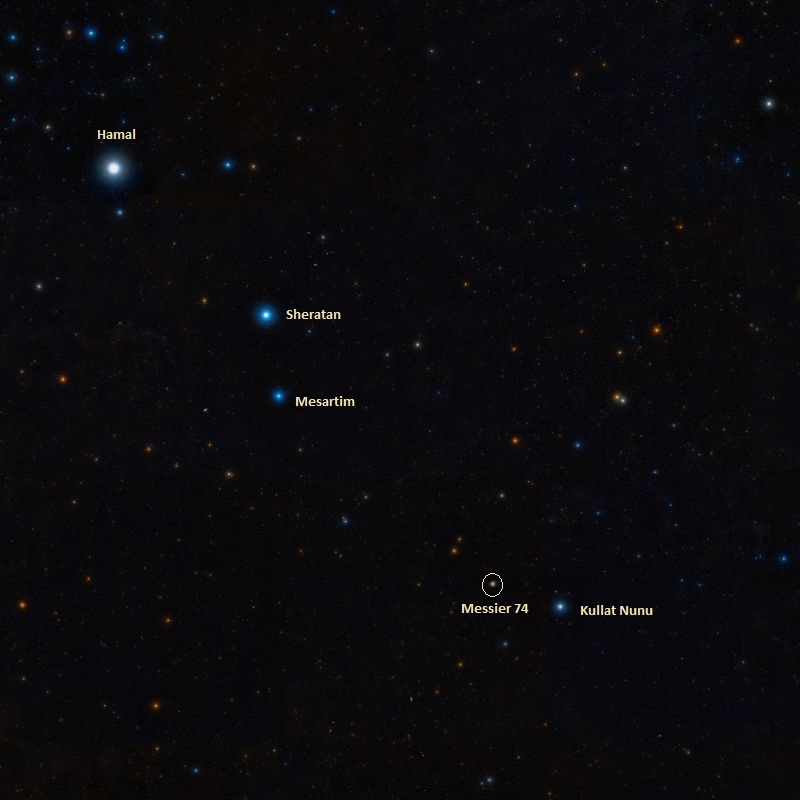Welcome back to Messier Monday! Today, we continue in our tribute to our dear friend, Tammy Plotner, by looking at the “Phantom Galaxy” known as Messier 74!
During the 18th century, famed French astronomer Charles Messier noticed the presence of several “nebulous objects” while surveying the night sky. Originally mistaking these objects for comets, he began to catalog them so that others would not make the same mistake. Today, the resulting list (known as the Messier Catalog) includes over 100 objects and is one of the most influential catalogs of Deep Space Objects.
One of these objects is the spiral galaxy known as Messier 74 (aka. the Phantom Galaxy) which appears face-on to observers from Earth. Located about 30 million light years from Earth in the direction of the Pisces constellation, this galaxy measures around 95,000 light years in diameter (almost as big as the Milky Way) and is home to about 100 billion stars.
Description:
This beautiful galaxy is a prototype of a grand-design Sc galaxy and among the first “Spiral Nebulae” recognized by Lord Rosse. Located some 30 to 40 million light years away from us, it is slowly slipping even further away at a speed of 793 kilometers per second. Its beauty spans roughly 95,000 light years, about the same size as our Milky Way and its spiral arms stretch out over 1000 light years.
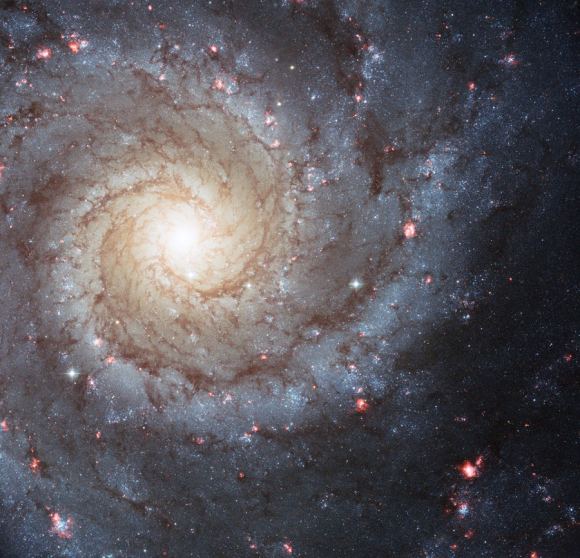
Inside those arms are clusters of blue young stars and pinkish colored diffuse gaseous nebulae called H II regions where star formation is happening. Why such a sweeping grand beauty? Chances are its the density waves sweeping around M74’s gaseous disk, probably induced by gravitational interaction with neighboring galaxies. As B. Kevin Edgar explained:
“A numerical method is described which is specifically designed to treat the dynamics of an infinitesimally this, differentially rotating, gaseous disk. The method is based on the Piecewise Parabolic Method (PPM), a higher-order extension of Godunov’s method. Gravitational forces representing a linear spiral density wave in the stellar component of a galaxy are included. The calculation is Eulerian and is performed in a uniformly rotating frame of reference using plane polar coordinates. The equations are formulated in an exact perturbation form to explicitly eliminate all large, opposing terms representing force balance in the unperturbed, axis symmetric state, allowing the accurate computation of small perturbations. The method is ideally suited to the study of the gaseous response to a spiral density wave in a disk galaxy. A series two-dimensional hydrodynamical models is computed to test the gravitational response of a uniform, isothermal, massless gaseous disk to an imposed spiral gravitational perturbation. The parameters describing the mass distribution, rotation properties, and the spiral wave are based on the galaxy NGC 628. The solutions have shocks inside and outside co-rotation, depleting the region around co-rotation. The rate at which this region is depleted depends strongly on the strength of the imposed spiral perturbation. Potential perturbations of 10% of greater produce large radial inflows. The time needed for the gas to fall to the inner Linblad resonance in such models is only a small fraction of the Hubble time. The implied rapid evolution suggests that if galaxies exist with such large perturbations, either gas must be replenished from outside the galaxy or the perturbations must be transitory. Inside co-rotation with the spiral pattern, the loss of angular momentum by the gas increases the angular momentum of the stars, reducing the wave amplitude.”
What else is hiding inside? Then take a look with x-ray eyes. As Roberto Soria (et al) indicated in their 2002 study:
“The face-on spiral galaxy M74 (NGC 628) was observed by XMM-Newton on 2002 February 2. In total, 21 sources are found in the inner 5′ from the nucleus (after rejection of a few sources associated to foreground stars). Hardness ratios suggest that about half of them belong to the galaxy. The higher luminosity end of the luminosity function is fitted by a power law of slope -0.8. This can be interpreted as evidence of ongoing star formation, in analogy with the distributions found in disks of other late-type galaxies. A comparison with previous Chandra observations reveals a new ultraluminous X-ray transient (LX~1.5×1039 ergs s-1 in the 0.3-8 keV band) about 4′ north of the nucleus. We find another bright transient source (LX~5×1038 ergs s-1) about 5′ northwest of the nucleus. The UV and X-ray counterparts of SN 2002ap are also found in this XMM-Newton observation; the hardness ratio of the X-ray counterpart suggests that the emission comes from the shocked circumstellar matter.”
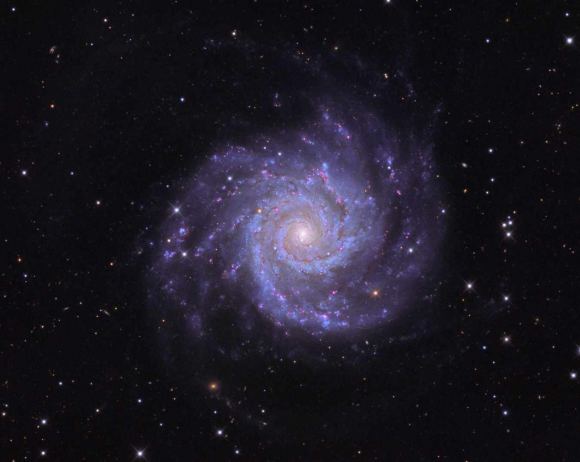
In Messier 74’s case, nothing is shocking – including its spiral density waves. As Sakhibov and Smirnov explained in a 2004 study:
“The radial profile of the star-formation rate (SFR) in the galaxy NGC 628 is shown to be modulated by a spiral-density wave. The radial profile of the velocity of gas inflow into the spiral arm is similar to the radial distribution of the surface density of the SFR. The position of the corotation resonance is determined along with other parameters of the spiral-density wave via a Fourier analysis of the azimuthal distribution of the observed radial velocities in annular zones of the disk of NGC 628. The radial profile of the surface density of the SFR is determined using the empirical SFR—linear size relation for star-formation complexes (giant HII regions) and measurements of the coordinates, H alpha fluxes, and the sizes of HII regions in NGC 628.”
We are talking about gigantic star forming regions, aren’t we? And where stars form…. Stars die. As in supernova! As Elias Brinks (et al) indicated:
“The formation of massive stars, usually in (super) star clusters, their rapid evolution and subsequent demise as supernovae has a major impact on their immediate surroundings. The combined effect of stellar winds and Supernovae, going off within rapid succession and within a small volume, creates expanding bubbles of coronal gas within the neutral Interstellar medium (ISM) In spiral and (dwarf) irregular galaxies. These expanding shells in turn sweep up and compress neutral gas which can lead to molecular cloud formation and the onset of secondary or induced star formation. Star forming areas disturb their surrounding ISM so a more “active”, in terms of star formation, galaxy is expected to have a more inhomogeneous ISM. The star formation rate in NGC 628 is four times higher than in NGC 3184 and twice as high as in NGC 6946, which could explain the greater number of HI holes found in this galaxy. We find that the sizes of the HI holes range from 80 pc (close to the resolution limit) to 600 pc; the expansion velocities can reach 20 km s1; estimated ages are 2.5 to 35 Myr and the energies involved range from 1050 to 3.5 x 105Z ergs. The amount of neutral gas involved is of order 104 to 106 solar masses.”
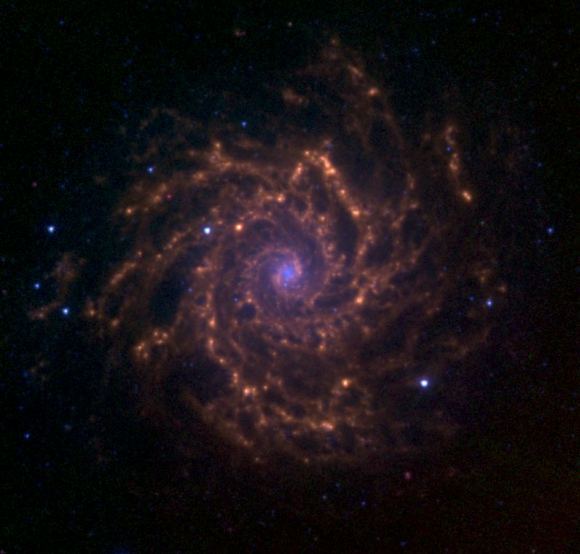
Huge masses… Masses that sometimes… disappear?? As Justyn R. Maund and Stephen J. Smartt explained in a 2009 study:
“Using images from the Hubble Space Telescope and the Gemini Telescope, we confirmed the disappearance of the progenitors of two type II supernovae (SNe) and evaluated the presence of other stars associated with them. We found that the progenitor of SN 2003gd, an M-supergiant star, is no longer observed at the SN location and determined its intrinsic brightness using image subtraction techniques. The progenitor of SN 1993J, a K-supergiant star, is also no longer present, but its B-supergiant binary companion is still observed. The disappearance of the progenitors confirms that these two supernovae were produced by red supergiants.”
Maund and Smartt used a technique where images were taken after SN 2003gd had faded away, and the progenitor star was presumably missing, and subtracted from the pre-explosion images. Anything left over at the SN position corresponded to the real progenitor star. The Gemini observations of 2003gd are shown in Figure 1 which compares pre- and post-supernova views of the progenitor star’s region of the galaxy know as M-74 or NGC 628.
“This is the first red supergiant progenitor for a normal Type IIP supernova which has been shown to have disappeared and it’s at the low mass end of the scale for massive stars to explode as supernovae,” said Maund. “So, it finally confirms that a standard prediction of a number of stellar evolution models is correct.”
Evolving? You betcha’. Messier 74 is continuing, despite its age, to grow up! As A.S. Gusev (et al) indicated:
“Interpretation of observed properties of young stellar population in NGC 628 is carried out on the basis of the comparison of the high resolution UBVRI photometry data of 127 H-alpha regions in the galaxy with the detailed grid of the synthetic evolutionary models of stellar systems. The detailed grid of evolutionary models includes 2 regimes of star formation (instantaneous burst and a constant star formation), whole range of IMF (slope and an upper mass limit) and age (from 1 Myr up to 100 Myrs). The chemical abundance of the star forming regions was determined from the independent observations. The solution of the reverse problem of finding of age, regime of star formation, IMF parameters, and dust absorption in the star forming regions is produced with the aid of a special regularizing deviation functional. Reddening estimations are correlated with galactocentric distances of star forming regions, in conformity with a chemical abundance radial gradient derived from independent observations. Ages of star formation complexes also show a trend as a function of chemical composition.”
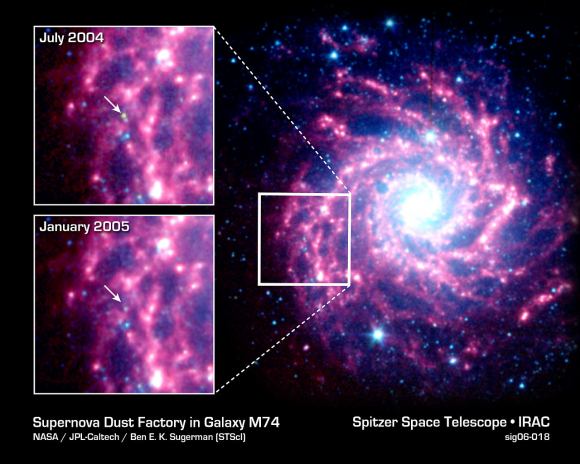
So exactly where do such large groups of young stars go to hang out and relax? Maybe… Just maybe they are trying to form a neighborhood bar. A galactic bar, of course! As M. S. Seigar of the Joint Astronomy Centre said in a 2002 study:
“We have obtained ground-based I, J and K band images of the spiral galaxy, Messier 74 (NGC 628). This galaxy has been shown to possess a circumnuclear ring of star formation from both near-infrared spectroscopy of CO absorption and sub-millimetre imaging of CO emission. Circumnuclear rings of star formation are believed to exist only as a result of a bar potential. We show evidence for a weak oval distortion in the centre of M 74. We use the results of Combes & Gerin (1985) to suggest that this weak oval potential is responsible for the circumnuclear ring of star formation observed in M 74.”
History of Observation:
This awesome spiral galaxy was originally discovered at the end of September 1780 by Pierre Mechain and then dutifully re-observed and logged by Charles Messier on October 18, 1780.
“Nebula without stars, near the star Eta Piscium, seen by M. Mechain at the end of September 1780, and he reports: “This nebula doesn’t contain any stars; it is fairly large, very obscure, and extremely difficult to observe; one can recognize it with more certainty in fine, frosty conditions”. M. Messier looked for it and found it, as M. Mechain describes it: it has been compared directly with the star Eta Piscium.”
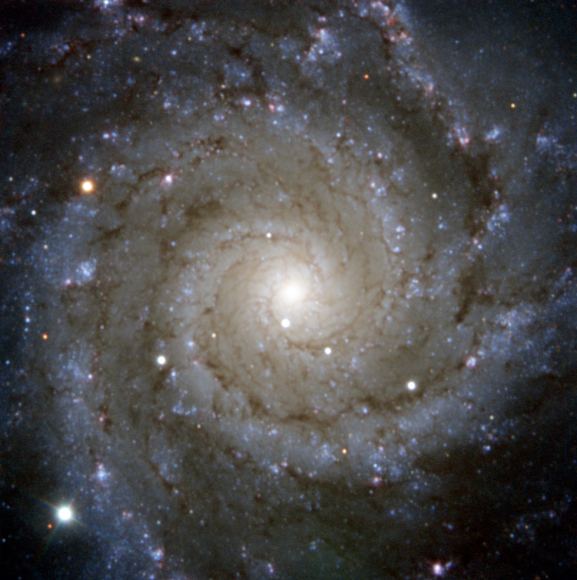
Three years later, Sir William Herschel would do his best to try to resolve what he believed to be a star cluster – and return in consequent years, even at the expense of his own equipment.
“1799, December 28, 40 feet telescope. Very bright in the middle, but the brightness confined to a very small part, and is not round; about the bright middle is a very faint nebulosity to a considerable extent. The bright part seems to be of resolvable kind, but my mirror has been injured by condensed vapours.”
To give Sir William credit, he was the first to resolve some of the many clumps of starbirth regions to be seen in Messier 74, and the results of his observations were later confirmed by his own son.
John Herschel would also see mottling in the structure of M74, yet Lord Rosse was the first to pick out the spiral structure. Again, at the time the astronomers believed these condensations to be individual stars – an observation passed along as far as Emil Dreyer’s time when Messier 74 eventually became an NGC object as well.
Locating Messier 74:
M74 isn’t always an easy object and requires dark skies and some starhopping. Try begining at Alpha Arietis (Hamal) and make a mental line between it and Beta – then on to Eta Piscium. Center your finderscope at Eta and shift the view about 1.5 degrees northeast. If you prefer, you can do this while looking through a wide field, low magnification eyepiece – which normally delivers about a degree field of view.
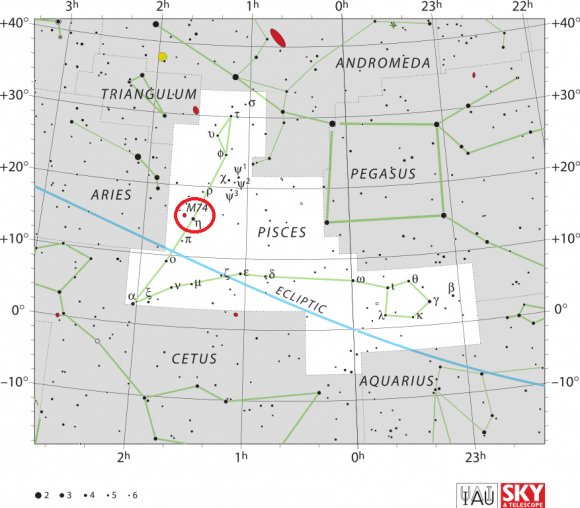
In a smaller telescope, the first thing you will notice is Messier 74’s stellar nucleus. This is why many times observer’s have difficulty locating it! Believe it or not, movement can sometimes help you spot fainter things, so using the eyepiece to locate it is a good observer’s “trick of the trade”. Because this spiral galaxy is low surface brightness, it does require relatively good skies – so try under many conditions. A small telescope will reveal a dusty halo around the core region, while larger aperture will reveal the spiral structure. Large binoculars under pristine sky conditions can make out a small faint haze!
Study it yourself… Who knows what you might discover!
Object Name: Messier 74
Alternative Designations: M74, NGC 628
Object Type: Sc Spiral Galaxy
Constellation: Pisces
Right Ascension: 01 : 36.7 (h:m)
Declination: +15 : 47 (deg:m)
Distance: 35000 (kly)
Visual Brightness: 9.4 (mag)
Apparent Dimension: 10.2×9.5 (arc min)
We have written many interesting articles about Messier Objects and globular clusters here at Universe Today. Here’s Tammy Plotner’s Introduction to the Messier Objects, M1 – The Crab Nebula, Observing Spotlight – Whatever Happened to Messier 71?, and David Dickison’s articles on the 2013 and 2014 Messier Marathons.
Be to sure to check out our complete Messier Catalog. And for more information, check out the SEDS Messier Database.
Sources:

